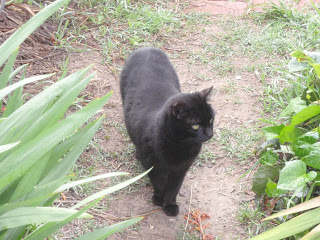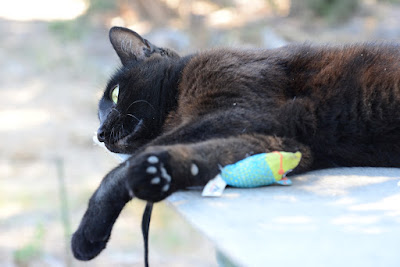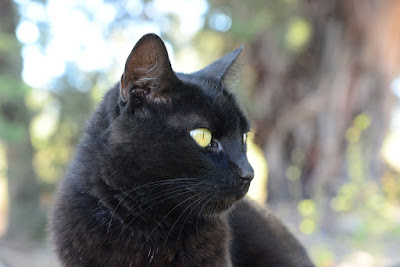We procured a bookcase (with doors to keep critters out) for a garden lending library. It's in the regular toolshed, focusing on books on gardening and cooking. I think the two go hand in hand as gardening allows you to grow things not commonly available in stores and/or grow better tasting veg than you can get anywhere, and you need recipes/skills to cook them; meanwhile, cookbooks introduce you to ingredients that you may want to grow in the future! For now please use the whiteboard on the front of the other shelves for a sign out sheet.
For the garden books, there are/will be some all-around books, some focusing on composting, an insect pest ID book, some on heirloom seeds, and some books from ES faculty members Liz Carlisle and David Cleveland that I've read and really liked.
For the cookbooks, some are seminal veg texts from the 70s, some are photo heavy for inspiration, some text heavy for knowledge. Currently it's a bit biased towards America and Europe but that's only cause I haven't tracked down some of the other books I want to get.
There are also some books from garden member Andy that are really good and some cookbooks I had laying around that may or may not be of interest. Here's an annotated bibliography of the books I recommend.
The Kitchen Garden, Sylvia Thompson, she gardens up in the mountains above LA so somewhat relevant to our climate. Very thorough info and she has growing tips for many, many types of plants.
The Kitchen Garden A-Z, Mike McGrath, the author is super knowledgeable, he ran Organic Gardening magazine for many years and also hosts a radio show about gardening. Pretty sure I've mentioned him before on the garden blog. Big coffee table-style book, lots of pictures, basic text. Great for beginners and inspiration.
Baker Creek seed catalog, we recommend the local store Island Seed and Feed, but I don't drive, so buy alot online. Baker Creek (rareseeds.com) has an astounding variety of veg - both different species and variety within each species. Their catalog is great for inspiration.
Cooking from the Garden, Rosalind Creasy, fantastic and prolific author. This book is organized around growing specific gardens in order to have ingredients for specific ethnic cuisines. Also a ton of general gardening info.
Earthly Delight, Rosalind Creasy
Blue potatoes, orange tomatoes, Rosalind Creasy, a children's book, basic gardening info
the Art of the Kitchen Garden, Ethne Clarke, garden design, nice watercolors
Worms eat my Garbage, all about vermicomposting
Let it rot!, good book about composting
Mike McGrath's book of compost, good book, has a humorous bent
Rodale's color handbook of garden insects, useful
On Good Land, History of Fairview Gardens and a bit of history of Goleta Valley in general.
Heirloom Vegetables, book on seed saving, old varieties, etc
the Heirloom Gardener, book on seed saving, old varieties, etc
American Grown - the White House kitchen garden, by Michelle Obama
Hippie Food, I loved this book, ties together the natural food movement that began in the 70s with organic gardening and the back to the land movement. Very well written.
Grain by Grain, Liz Carlise, about Kamut wheat farming in Montana, how growing non-commodity crops might save american small farmers. Super inspiring
Lentil Underground, Liz Carlise, about lentil farming in Montana, how growing non-commodity crops might save american small farmers. Super inspiring
Food Gardens for a Changing World, David Cleveland
Golden Gate Gardening, about SF but also generally about gardening in coastal (foggy) CA which is us
The California Landscape Garden, a ton of local-ish info
Tassajara Cooking, Edward Espe Brown, written by a Zen Buddhist monk who worked at the Tassajara Hot Springs retreat in Big Sur. Beyond excellent book for the beginning cook, shows how to hold a knife, how to cut veg, how to use veg, helps you understand food and cooking.
Moosewood Cookbook, Mollie Katzen, one of the original 70s veg cookbooks, pretty dairy heavy, handwritten/handdrawn. Classic
the Enchanted Broccoli Forest, Mollie Katzen, her second book
Chez Panisse Cooking, Paul Bertolli, one of the original farm to table cookbooks, CA, fantastic
the Victory Garden Cookbook, 80s, covers an insane variety of veg, definitely some you won't have heard of. a couple of pics are cut out of this copy
Faye Levy's International Vegetable Cookbook, excellent coverage of veg, recipes more interesting (to me) than Victory Garden
Classic Vegetarian Cooking from the Middle East and North Africa, I got this because it has a bunch of fava bean recipes. later got a hardcover version so the garden gets the paperback. Authentic.
Super Natural Cooking, a modern cookbook, a ton of pics, CA vegan cooking.
Verdura, Viana la Place, CA vegetable cooking with an italian influence, really good writer
the Unplugged Kitchen, Viana la Place, CA simpler cooking, really good writer
New Vegan Cookbook, Lorna Sass, smaller book but good ideas
From an Ecological Kitchen, Lorna Sass, bigger book, lots of knowledge
Jamie at Home, he changed the way I cook, focuses on ingredient quality, and makes difficult things approachable, this particular book is about farm to table recipes. The Naked Chef is also great.
Jamie's Italy, superb
Jamie's Food escapes, a travel book, shorter sections on Greece, Italy, Spain, Morocco
Bistro Cooking, Patricia Wells, fabulous french cookbook, practical/not fussy
Trattoria, Patricia Wells, does the same for italian food
Italian Country Table, Lynne Rossetto Kasper, one of the best books on italian food
the Glass Pantry, Georgeanne Brennan, prolific author, this book on preserving food is beautiful and great. I've made the eggplant/balsamic preserve many times
World-of-the-east vegetarian cooking, superb older veg cookbook





.jpg)






















































